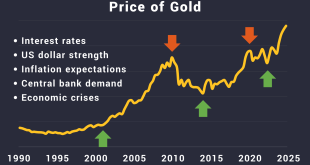Gold. It’s shiny, it’s valuable, and for ages, people have stashed it away thinking it’s the ultimate safety net. But is it really that simple? Are we missing something by just seeing it as a hedge against doom and gloom? I think so. Let’s shake things up and explore how we can view gold as part of a bigger, more dynamic investment strategy, specifically within the world of alternative investments. Think of it less like a static rock and more like a player you can strategically deploy depending on the game. It’s about understanding its potential and fitting it into what I’d like to call a “portfolio continuum.” What do you think? Sounds intriguing, right?
Understanding the Traditional Role of Gold
Gold as a Safe Haven
Okay, let’s be real. We all know gold’s reputation. It’s the go-to safe haven, the asset people run to when the stock market looks like it’s about to take a nosedive, or when political tensions get a little too spicy. The idea is that gold holds its value – or even increases – when other investments are tanking. It’s like that one friend who always stays calm during a crisis, you know? That’s why many investors traditionally allocate a portion of their portfolio to gold, just in case. You can’t deny that it can provide a sense of security.
Limitations of the Traditional View
But here’s the catch: relying solely on this “safe haven” narrative can be a bit limiting. Treating gold as just a crisis-only asset means you might miss out on other opportunities. It’s not always the best performer, and sometimes, it just sits there, doing nothing while other investments are making moves. Plus, the gold price can be volatile too, affected by interest rates, currency movements, and even just plain old market sentiment. So, blindly sticking to the traditional view? Maybe not the smartest move. Don’t you agree?
The Portfolio Continuum: A New Perspective
Defining the Portfolio Continuum
So, what’s this “portfolio continuum” I keep mentioning? Well, it’s a way of looking at your investments not as separate, isolated entities, but as a range of options with varying degrees of risk and return potential. Imagine a spectrum, where on one end, you have super conservative, low-risk assets, and on the other, you have more aggressive, high-growth investments. The goal is to find the right balance, the sweet spot that aligns with your personal risk tolerance, time horizon, and financial goals. Finding your spot can be tricky though. I still haven’t found mine!
Gold’s Position on the Continuum: A Dynamic Allocation
Now, where does gold fit into this continuum? That’s the fun part – it’s not fixed! Instead of thinking of gold as a static allocation, you can adjust its position based on market conditions and your investment objectives. In times of uncertainty, you might want to increase your gold exposure, moving it closer to the “safe haven” end of the spectrum. But when the economy is booming and risk appetite is high, you might reduce your gold holdings and allocate those funds to more growth-oriented assets. It’s all about being flexible and adapting to the environment. I think this is where the real opportunity lies.
Gold’s Unique Attributes in Alternative Investments
Inflation Hedge and Currency Devaluation Protection
Beyond its safe-haven status, gold has some other tricks up its sleeve. It’s often seen as a pretty solid inflation hedge. As the value of currency erodes, gold tends to maintain its purchasing power. Think of it as a life raft against the rising tide of inflation. This is particularly relevant in alternative investments, where you might be holding assets that are less liquid or more susceptible to inflationary pressures. Plus, it can act as a shield against currency devaluation, especially if you’re investing in international markets.
Diversification Benefits Beyond Traditional Assets
Here’s another plus: gold can bring diversification benefits that you might not get from traditional assets like stocks and bonds. Its price doesn’t always move in sync with these assets, which means it can help to reduce overall portfolio volatility. In an alternative investment portfolio, which might include things like real estate, private equity, or hedge funds, adding gold can provide an extra layer of stability and potentially improve risk-adjusted returns. It’s like adding a secret ingredient to your investment recipe – you know, just to make it pop a little more.
Liquidity Considerations in Alternative Strategies
Okay, let’s talk about liquidity. Alternative investments can sometimes be less liquid than traditional assets. Selling a building takes longer than selling a stock. Gold, on the other hand, can be relatively liquid, especially if you hold it in the form of ETFs or certain mining stocks. This liquidity can be a valuable asset in an alternative strategy, providing you with the flexibility to rebalance your portfolio or raise cash when needed. It’s like having an emergency exit in a complex building – hopefully, you won’t need it, but it’s good to know it’s there.
Implementing a Gold-Focused Alternative Strategy
Identifying Risk Tolerance and Investment Objectives
Before you dive headfirst into adding gold to your alternative investment portfolio, you need to do some soul-searching. What’s your risk tolerance? Are you the type who can stomach big swings in value, or do you prefer a smoother ride? What are your investment goals? Are you trying to preserve capital, generate income, or achieve long-term growth? Your answers to these questions will guide how much gold you allocate and how actively you manage it.
Choosing the Right Gold Exposure (Physical, ETFs, Mining Stocks)
Now, let’s talk about how you actually get your hands on gold. You’ve got options! You can buy physical gold – bars, coins, jewelry (if you’re feeling fancy). You can invest in gold ETFs, which track the price of gold. Or, you can buy stock in gold mining companies. Each option has its pros and cons. Physical gold gives you direct ownership, but it can be a hassle to store and insure. ETFs are liquid and easy to trade, but you don’t actually own the gold. Mining stocks can offer leverage to the gold price, but they also come with company-specific risks. Decide what you’re most comfortable with, you know?
Monitoring and Adjusting the Portfolio Allocation
Once you’ve got your gold allocation in place, don’t just forget about it! You need to monitor its performance and adjust your portfolio as needed. Keep an eye on economic indicators, market trends, and any factors that could impact the gold price. Be prepared to rebalance your portfolio periodically to maintain your desired asset allocation. Think of it like tending a garden – you can’t just plant the seeds and walk away; you need to water, weed, and prune as needed.
Case Studies: Gold in Alternative Investment Portfolios
Example 1: Capital Preservation in a Volatile Market
Let’s say you’ve got a portfolio of alternative investments, including real estate and private equity. The market’s getting shaky, and you’re worried about potential losses. You could increase your allocation to gold, shifting it towards the “safe haven” end of the continuum. This could help to cushion the blow if your other investments take a hit.
Example 2: Enhancing Returns with Tactical Gold Allocation
On the flip side, imagine the economy’s starting to heat up, and inflation is on the rise. You could tactically allocate a portion of your portfolio to gold, betting that it will outperform other assets in an inflationary environment. This could potentially enhance your returns while still providing some downside protection.
So, there you have it. I hope that’s given you a new way to think about gold. Instead of just seeing it as a static, boring old store of value, consider it as a dynamic tool that can be strategically deployed within your alternative investment portfolio. By understanding its unique attributes and implementing a flexible allocation strategy, you can potentially enhance your returns, reduce your risk, and navigate the ever-changing investment landscape with greater confidence. Now, go forth and explore the golden possibilities. And hey, if you figure out the perfect formula, let me know!
 seeme
seeme



